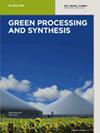从木瓜叶提取物中合成的锰和铜包覆氧化镍纳米颗粒通过触发线粒体卡巴酶和 p53 诱导抗菌活性和乳腺癌细胞死亡
IF 3.8
4区 工程技术
Q2 CHEMISTRY, MULTIDISCIPLINARY
引用次数: 0
摘要
本研究利用木瓜提取物通过绿色工艺制备了锰铜共掺氧化镍纳米粒子(MnCu co-doped NiO NPs)。通过 X 射线衍射(XRD)、紫外可见光、傅立叶变换红外光谱、场发射扫描电子显微镜、能量色散 X 射线分析和光致发光(PL)光谱对 MnCu 共掺杂 NiO NPs 进行了表征。XRD 图谱表明,合成的锰铜共掺杂氧化镍 NPs 呈立方结构。在光致发光光谱上,发现了各种表面缺陷。锰铜共掺杂的氧化镍 NPs 在 37°C 时具有铁磁性。绿色合成的锰铜共掺杂 NiO NPs 对人类病原体(大肠杆菌、肺炎链球菌、巨大芽孢杆菌、枯草芽孢杆菌、志贺氏痢疾杆菌、铜绿假单胞菌)和真菌白色念珠菌具有抗菌活性。锰铜共掺杂的氧化镍氮氧化物处理大大降低了 MDA-MB-231 细胞的存活率,而对 HBL-100 细胞的存活率没有影响。不同的荧光染色分析表明,掺杂 MnCu 的 NiO NPs 能诱导细胞核和线粒体损伤,从而增加自由基的产生,改变线粒体膜蛋白电位,导致 MDA-MB-231 细胞凋亡。锰铜共掺杂 NiO NP 处理可增强促凋亡蛋白的表达,并抑制 MDA-MB-231 细胞 S 期的细胞周期。这使得利用木瓜提取物制造锰铜共掺杂的氧化镍氮氧化物变得简单、廉价和环保,而木瓜提取物具有优异的抗菌特性。本文章由计算机程序翻译,如有差异,请以英文原文为准。
Manganese and copper-coated nickel oxide nanoparticles synthesized from Carica papaya leaf extract induce antimicrobial activity and breast cancer cell death by triggering mitochondrial caspases and p53
In the present work, manganese–copper co-infused nickel oxide nanoparticles (MnCu co-doped NiO NPs) were formulated via a green process using Carica papaya extract. The MnCu co-doped NiO NPs were characterized by X-ray diffraction (XRD), UV–Vis, Fourier transform infrared, field emission scanning electron microscope, energy dispersive X-ray analysis, and photoluminescence (PL) spectrum. The XRD pattern demonstrated that synthesized MnCu co-doped NiO NPs exhibit cubic structure. On the PL spectrum, various surface defects were identified. MnCu co-doped NiO NPs exhibited ferromagnetic properties at 37°C. The antimicrobial activity of green synthesis MnCu co-doped NiO NPs against human pathogens (Escherichia coli, Streptococcus pneumoniae, Bacillus megaterium, Bacillus subtilis, Shigella dysenteriae, Pseudomonas aeruginosa) and Candida albicans as fungal strains were demonstrated. The MnCu co-doped NiO NPs treatment considerably reduced MDA-MB-231 cell viability while not disturbing HBL-100 cell viability. Different fluorescent staining analyses revealed that MnCu co-doped NiO NPs induced nuclear and mitochondrial damage to improve free radical production, altering mitochondrial membrane protein potential, which led to apoptotic cell death in MDA-MB-231 cells. The MnCu co-doped NiO NP treatment enhanced pro-apoptotic protein expression and inhibited the cell cycle at the S phase in MDA-MB-231 cells. This makes it easy, cheap, and environmentally friendly to make MnCu co-doped NiO NPs using C. papaya extract, which has excellent antimicrobial properties.
求助全文
通过发布文献求助,成功后即可免费获取论文全文。
去求助
来源期刊

Green Processing and Synthesis
CHEMISTRY, MULTIDISCIPLINARY-ENGINEERING, CHEMICAL
CiteScore
6.70
自引率
9.30%
发文量
78
审稿时长
7 weeks
期刊介绍:
Green Processing and Synthesis is a bimonthly, peer-reviewed journal that provides up-to-date research both on fundamental as well as applied aspects of innovative green process development and chemical synthesis, giving an appropriate share to industrial views. The contributions are cutting edge, high-impact, authoritative, and provide both pros and cons of potential technologies. Green Processing and Synthesis provides a platform for scientists and engineers, especially chemists and chemical engineers, but is also open for interdisciplinary research from other areas such as physics, materials science, or catalysis.
 求助内容:
求助内容: 应助结果提醒方式:
应助结果提醒方式:


